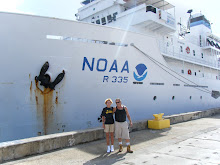Linda Tatreau
blogging as Shark Feet
This blog was created to share my experiences at sea with my students in Guam and other interested individuals. This page is one of my last entries into the blog. I have been at sea for 4 weeks now and I’ve loved every minute of it. As we near the end of the cruise, I have mixed emotions―part of me is anxious to return home and part of me doesn’t want this experience to end. I have learned so much, had so much fun and I’ve made 42 new friends.
I’ve lived and taught on Guam for 20 years. I teach marine biology at the best public high school on Guam, George Washington High. What could be better than teaching marine biology on a tropical paradise island?
I have been very fortunate in being able to experience ocean exploration and to share it with my students. In 2003, I spent 7 weeks at sea; 6 weeks studying the blue mud volcanoes between the Mariana Islands and the Mariana Trench and 1 week on the backarc exploring hydrothermal vents. In May of 2009, I was aboard the Research Vessel Kilo Moana when it took the Remotely Operated Vehicle Nereus to the Challenger Deep, the deepest spot in the Mariana Trench. On this cruise, I am with NOAAs Teacher At Sea Program.
skip to main |
skip to sidebar




A survey of Fish around Guam and the CNMI to 250 meters
About this Cruise
This month-long cruise aboard the NOAA Ship Oscar Elton Sette brings together six diverse teams to survey fish populations using non-catch methods. Traditionally, fish populations have been assessed by catching fish, visiting fish markets and interviewing fishermen. Chief Scientist Scott Ferguson hopes to support Guam and the CNMI in monitoring their natural resources using non-extractive methods. The ship will also use multibeam sonar to map areas that are important fishery resources hopefully to include Galvez Bank, offshore slopes near Rota, and the banks of Farallon de Medinilla.
The survey methods include BotCams and BRUVs, two systems that put baited cameras on the bottom, and a TOAD which is a camera towed near the seafloor . An Autonomous Underwater Vehicle will travel on its own via computer programming and bring back photographs and video. Additionally, acoustic methods will be used to survey fish in the water column.
This expedition brings together scientists from NOAA’s Pacific Islands Fisheries Science Center and Northwest Fisheries Science Center, as well as the University of Hawaii’s Joint Institute for Marine and Atmospheric Research, the University of Guam Marine Lab, and Woods Hole Oceanographic Institution.
The survey methods include BotCams and BRUVs, two systems that put baited cameras on the bottom, and a TOAD which is a camera towed near the seafloor . An Autonomous Underwater Vehicle will travel on its own via computer programming and bring back photographs and video. Additionally, acoustic methods will be used to survey fish in the water column.
This expedition brings together scientists from NOAA’s Pacific Islands Fisheries Science Center and Northwest Fisheries Science Center, as well as the University of Hawaii’s Joint Institute for Marine and Atmospheric Research, the University of Guam Marine Lab, and Woods Hole Oceanographic Institution.
Pages
NOAA Ship Oscar Elton Sette

Fun Links
Rota, February 22-24
Galvez Bank, February 12-20

Linda and Lino prior to departure

